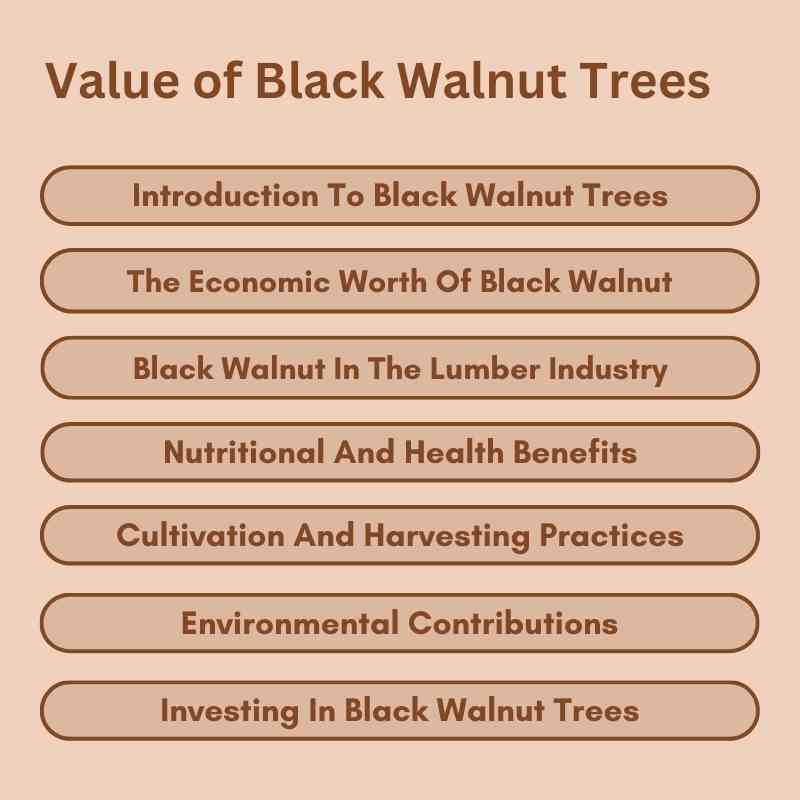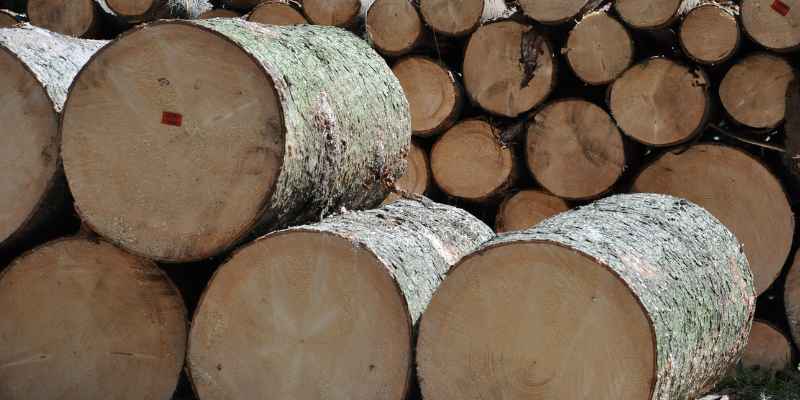The value of a Black Walnut tree ranges from $200 to $400 per tree, depending on size and quality. Its high-quality wood is prized for furniture and cabinetry.
Black Walnut trees (Juglans nigra) are renowned for their striking beauty and valuable hardwood. They thrive in North America and can grow up to 100 feet tall, making them a popular choice for landscaping. Beyond aesthetics, their wood is highly sought after for its rich color and durability, often used in luxury furniture and flooring.
The nuts also provide nutritional benefits, attracting wildlife and enhancing local ecosystems. Cultivating Black Walnut trees can be a rewarding venture, both financially and environmentally, appealing to homeowners and landowners alike. Understanding their value is essential for anyone considering planting or harvesting these majestic trees.
Introduction To Black Walnut Trees
The Black Walnut tree is a remarkable species known for its beauty and value. This tree offers both aesthetic appeal and practical benefits. From its rich wood to its delicious nuts, the Black Walnut tree holds a special place in nature.
Species Profile
The Black Walnut tree (Juglans nigra) is a large deciduous tree. It can grow up to 100 feet tall. This tree is native to North America and thrives in rich, well-drained soils. Here are some key features:
| Feature | Details |
|---|---|
| Height | 50 to 100 feet |
| Spread | 40 to 75 feet |
| Leaves | Pinnate, 12 to 24 inches long |
| Fruit | Round, green husk containing a hard-shelled nut |
| Wood | Dark brown, strong, and durable |
Black Walnut trees grow best in full sun. They prefer moist, fertile soil. Their nuts are edible and highly nutritious.
Historical Significance
The Black Walnut tree has a rich history. Native Americans used its wood for tools and canoes. They also consumed the nuts and used the husks for dyes.
Early settlers valued the tree for its strong wood. They crafted furniture, cabinets, and flooring from it. Today, Black Walnut wood is still sought after for its beauty.
- Wood is used in high-end furniture.
- Nuts are harvested for snacks and cooking.
- Environmental benefits include soil improvement.
The Black Walnut tree is not just a source of products. It is also a symbol of heritage and sustainability.

The Economic Worth Of Black Walnut
The Black Walnut tree is not just a beautiful addition to landscapes. It holds significant economic value. Its timber, nuts, and other products contribute to various markets. Understanding its worth helps landowners make informed decisions.
Timber Market Prices
Black Walnut timber is highly sought after. It is prized for its strength and rich color. Here are some key points about its market prices:
- High-quality lumber can fetch between $3 to $10 per board foot.
- Prices vary based on tree size and quality.
- Logs with minimal defects are more valuable.
Tables below show average prices based on quality:
| Quality Grade | Price per Board Foot |
|---|---|
| FAS (First and Seconds) | $8 – $10 |
| Select | $5 – $7 |
| Common | $3 – $4 |
Factors Influencing Value
Several factors influence the value of Black Walnut trees. Understanding these can maximize profit:
- Tree Size: Larger trees yield more valuable lumber.
- Quality: Fewer defects mean higher prices.
- Market Demand: High demand increases timber prices.
- Location: Proximity to mills can affect selling prices.
- Condition: Healthy trees are more valuable.
Landowners should consider these factors. They help in assessing the potential income from Black Walnut trees.
Black Walnut In The Lumber Industry
The Black Walnut tree holds immense value in the lumber industry. Its rich color and durability make it a sought-after material. Craftsmen and builders favor it for various applications. Let’s explore its demand and uses in this industry.
Demand For Hardwood
The demand for hardwood like Black Walnut is high. This wood is known for its strength and beauty. Here are some factors driving its demand:
- Luxury furniture: Black Walnut is a top choice for high-end furniture.
- Flooring: Its durability makes it ideal for elegant flooring.
- Cabinetry: Many choose Black Walnut for kitchen and bathroom cabinets.
- Musical instruments: Fine instruments often use Black Walnut for its rich tone.
Uses And Applications
Black Walnut wood has diverse uses. Here are some popular applications:
| Application | Description |
|---|---|
| Furniture | Used for tables, chairs, and cabinets. |
| Flooring | Provides a warm and inviting look. |
| Cabinetry | Enhances the beauty of kitchens and bathrooms. |
| Woodworking | Ideal for intricate carvings and crafts. |
| Musical Instruments | Used in pianos, guitars, and violins. |
Black Walnut’s unique characteristics include:
- Color: Deep brown with beautiful grain patterns.
- Durability: Resistant to wear and tear.
- Workability: Easy to shape and finish.
Its popularity will likely continue to grow. Black Walnut offers both beauty and functionality in every application.
Nutritional And Health Benefits
The Black Walnut tree offers more than beautiful wood. Its nuts are packed with nutritional benefits. These nuts are a rich source of vitamins, minerals, and healthy fats. Enjoying them can boost overall health and well-being.
Edible Nuts Market
Black Walnuts are popular in the edible nuts market. Here are some key points:
- High in protein content.
- Rich in omega-3 fatty acids.
- Contains antioxidants that fight free radicals.
- Offers a unique, rich flavor.
In 2022, the global nut market reached a value of $150 billion. Black Walnuts play a significant role in this growth. They are often used in snacks, baked goods, and gourmet dishes.
| Nutrient | Amount per 100g |
|---|---|
| Protein | 24g |
| Fat | 60g |
| Fiber | 6g |
| Vitamin E | 0.7mg |
Medicinal Properties
Black Walnuts possess various medicinal properties. They have been used traditionally for health benefits. Here are some notable effects:
- Supports heart health.
- Helps regulate blood sugar levels.
- Promotes digestive health.
- Contains anti-inflammatory compounds.
Studies show that walnuts may lower the risk of heart disease. Their high antioxidant content can reduce oxidative stress. This nut is a natural source of melatonin, aiding sleep.
Incorporating Black Walnuts into your diet can enhance your overall health. Enjoy them in salads, desserts, or as a snack. Their unique flavor and health benefits make them a valuable addition.
Environmental Contributions
The Black Walnut tree plays a vital role in our environment. Its contributions extend beyond providing valuable wood. It aids in ecosystem balance and supports biodiversity.
Ecosystem Services
Black Walnut trees offer various ecosystem services that benefit the environment:
- Habitat Creation: Provides shelter for many species.
- Soil Improvement: Enhances soil quality through leaf litter.
- Water Regulation: Helps in maintaining water cycles.
- Biodiversity Support: Attracts various wildlife species.
These services lead to healthier ecosystems. They support both flora and fauna.
Carbon Sequestration
Black Walnut trees are excellent at carbon sequestration. They absorb carbon dioxide from the atmosphere. This helps combat climate change.
Here’s how it works:
| Process | Description |
|---|---|
| Photosynthesis | Trees convert CO2 into oxygen and glucose. |
| Growth | As trees grow, they store carbon in their wood. |
| Longevity | Long-lived trees store carbon for years. |
Each Black Walnut tree can store significant amounts of carbon. This contributes to a healthier planet.
Cultivation And Harvesting Practices
The Black Walnut tree is valued for its wood and nuts. Cultivating this tree requires specific methods. Proper practices ensure healthy growth and a fruitful harvest. Understanding these practices is essential for success.
Best Practices
Implementing best practices helps in growing Black Walnut trees effectively. Here are some important tips:
- Soil Preparation: Choose well-drained soil. Test pH levels. Ideal pH is between 6.0 and 7.5.
- Planting: Space trees at least 40 feet apart. This allows for growth.
- Irrigation: Water regularly, especially during dry spells. Avoid overwatering.
- Fertilization: Use a balanced fertilizer annually. This promotes healthy growth.
- Pest Management: Monitor for pests. Use organic pesticides when necessary.
Challenges And Solutions
Growing Black Walnut trees can present challenges. Here are common issues and their solutions:
| Challenge | Solution |
|---|---|
| Root Rot | Improve drainage. Avoid waterlogged soil. |
| Pests | Use traps and organic pesticides. Regularly inspect trees. |
| Poor Soil Quality | Amend soil with compost. Conduct regular soil tests. |
| Weather Extremes | Provide windbreaks. Use mulch to regulate soil temperature. |
Following these practices and solutions ensures a successful Black Walnut harvest. With care, the trees can thrive and produce high-quality wood and nuts.
Investing In Black Walnut Trees
Investing in Black Walnut trees can be a smart choice. These trees offer numerous benefits. They produce valuable hardwood and enhance property value. Landowners can enjoy both short-term and long-term gains.
Prospects For Landowners
Black Walnut trees hold great prospects for landowners. Here are some key points:
- High-Value Timber: Black Walnut wood is highly sought after. It is used in furniture, cabinets, and flooring.
- Environmental Benefits: These trees improve soil health. They also support local wildlife.
- Tax Benefits: Planting trees can provide tax deductions. Consult a tax advisor for details.
Long-term Investment Strategy
Investing in Black Walnut trees requires a long-term strategy. Here are steps to consider:
- Site Selection: Choose a well-drained area with sunlight.
- Proper Planting: Space trees adequately for growth.
- Regular Maintenance: Prune and protect trees from pests.
- Harvest Planning: Wait 30-50 years for optimal wood quality.
Investing in Black Walnut trees can yield significant returns. The right approach enhances both growth and value.
| Investment Aspect | Details |
|---|---|
| Initial Costs | Lower than many other investments |
| Time to Maturity | 30-50 years for high-quality timber |
| Market Demand | Consistently high for Black Walnut |
Future Trends And Market Predictions
The black walnut tree holds promise for the future. Increased demand for its wood and nuts drives market changes. Understanding trends helps stakeholders make informed decisions.
Innovations In Processing
New technologies improve how black walnut is processed. These innovations enhance quality and efficiency.
- Advanced Sawing Techniques: Precision cutting reduces waste.
- Eco-friendly Treatments: Sustainable methods attract eco-conscious consumers.
- Automated Milling: Speed increases while maintaining quality.
These innovations create better products. They also increase profitability for manufacturers.
Forecasting Market Movements
Market trends indicate steady growth for black walnut products. Experts predict rising demand for both wood and nuts.
| Year | Projected Growth (%) |
|---|---|
| 2024 | 5% |
| 2025 | 7% |
| 2026 | 10% |
Key factors influencing market movements include:
- Consumer Preferences: Increased interest in natural products.
- Global Trade: Expanding markets for black walnut.
- Climate Considerations: Sustainable forestry practices.
Understanding these trends helps businesses adapt and thrive.

Frequently Asked Questions
What Is The Value Of Black Walnut Wood?
Black walnut wood is highly valued for its rich color and durability. It is often used in fine furniture, cabinetry, and musical instruments. The wood’s natural beauty and workability make it a favorite among woodworkers. Its scarcity also contributes to its higher market price.
How Much Do Black Walnut Trees Sell For?
The price of black walnut trees can vary widely. Factors include tree size, quality, and market demand. On average, mature trees can fetch anywhere from $10 to $20 per board foot. Properly managed forests may yield even higher prices for premium quality wood.
Are Black Walnut Trees Environmentally Beneficial?
Yes, black walnut trees offer several environmental benefits. They provide habitat for wildlife and improve soil health. Their extensive root systems help prevent erosion. Additionally, they can sequester carbon, contributing to climate change mitigation efforts.
How Long Does It Take To Grow A Black Walnut Tree?
Black walnut trees typically take 30 to 50 years to reach maturity. However, growth rates can vary based on soil quality and climate conditions. With proper care, these trees can thrive and produce valuable timber in a reasonable timeframe.
Conclusion
The Black Walnut tree offers immense value beyond its stunning appearance. Its wood is prized for furniture and flooring, while its nuts are a culinary delight. Planting this tree supports biodiversity and enhances soil health. Embracing the Black Walnut enriches both your landscape and local ecosystems, making it a worthy addition to any yard.

